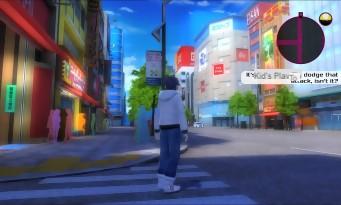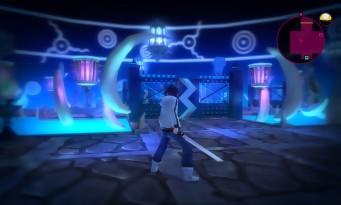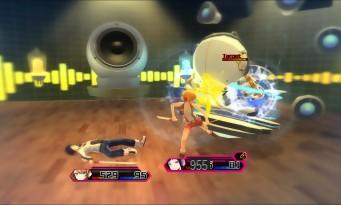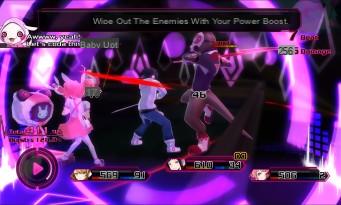 A true ode to Otaku culture, Akiba's Trip: Undead and Undressed had laid many foundations in terms of gameplay and it is with great surprise that we discover Akiba's Beat. If the title still retains its geek spirit, no need to have made the first episodes in order to be up to date. Indeed, the Acquire studio has decided to completely revise its formula by landing with a new scenario and new gameplay mechanics that radically change the gaming experience. Thus, you play as Asahi Tachibana, a young NEET (Not in Education, Employment or Training) who does nothing with her life and prefers playing video games to spending time with her friends. But while our hero is enjoying the Akihabara district, strange events will disrupt his weekend. Indeed, the people of Tokyo are responsible for creating DesilusionScape, dungeons that materialize their disappointments and house many demons. Very quickly, the phenomenon is growing and only a few people, including our hero, are able to overcome this problem.
A true ode to Otaku culture, Akiba's Trip: Undead and Undressed had laid many foundations in terms of gameplay and it is with great surprise that we discover Akiba's Beat. If the title still retains its geek spirit, no need to have made the first episodes in order to be up to date. Indeed, the Acquire studio has decided to completely revise its formula by landing with a new scenario and new gameplay mechanics that radically change the gaming experience. Thus, you play as Asahi Tachibana, a young NEET (Not in Education, Employment or Training) who does nothing with her life and prefers playing video games to spending time with her friends. But while our hero is enjoying the Akihabara district, strange events will disrupt his weekend. Indeed, the people of Tokyo are responsible for creating DesilusionScape, dungeons that materialize their disappointments and house many demons. Very quickly, the phenomenon is growing and only a few people, including our hero, are able to overcome this problem.
 As you can see, the storyline takes a 180 degree turn and moves completely away from the first episode. Here, Acquire seems to have above all bet on the affect of the Akihabara district. We're not going to lie to each other, the scenario is much less pleasant than before, but it allows you to discover Akihabara from another angle. As we noted earlier, the series is an ode to Otaku culture and Akiba's Beat continues this momentum. Throughout the story, players will meet many characters who will learn more about the neighborhood and its inhabitants. Many references to the Otaku culture come to flesh out the dialogues and this allows you to soak up even more of the very special atmosphere of the district. Without being a masterpiece, the story nevertheless manages to transport us throughout and is very pleasant to follow. The dialogues, although a little silly, are of very good quality and benefit from facial animations which make it possible to make the exchanges more dynamic. The only downside is the time loop in which our hero finds himself trapped. To put it simply, the entire scenario of the game takes place on one and the same Sunday, which is repeated constantly. If in the idea it could have been useful to the story, this loop leads above all to a redundancy which pushes to see the same events several times.
As you can see, the storyline takes a 180 degree turn and moves completely away from the first episode. Here, Acquire seems to have above all bet on the affect of the Akihabara district. We're not going to lie to each other, the scenario is much less pleasant than before, but it allows you to discover Akihabara from another angle. As we noted earlier, the series is an ode to Otaku culture and Akiba's Beat continues this momentum. Throughout the story, players will meet many characters who will learn more about the neighborhood and its inhabitants. Many references to the Otaku culture come to flesh out the dialogues and this allows you to soak up even more of the very special atmosphere of the district. Without being a masterpiece, the story nevertheless manages to transport us throughout and is very pleasant to follow. The dialogues, although a little silly, are of very good quality and benefit from facial animations which make it possible to make the exchanges more dynamic. The only downside is the time loop in which our hero finds himself trapped. To put it simply, the entire scenario of the game takes place on one and the same Sunday, which is repeated constantly. If in the idea it could have been useful to the story, this loop leads above all to a redundancy which pushes to see the same events several times.
THE DUNGEON CLEANER
 In order to restore calm and order in Akihabara, our hero will meet Saki Hoshino, a young girl who can also detect the DesilusionScape. Together, you will have to survey the different dungeons that are created in the neighborhood and overcome the many demons that come to squat there. Overall, the dungeons are quite enjoyable to run through, and the different themes that make up each instance give the game real flavor. Basically, each DesilusionScape has a theme that echoes the disappointments of the victims. Visually, the dungeons are quite pretty but we quickly lose our enthusiasm when we discover their construction. Overall, you'll only need to move from area to area in order to take on multiple packs of enemies. Gradually, the dungeons become more complex and take on the appearance of puzzles. Unfortunately, it seems that Acquire didn't really worry about this aspect, the puzzles being as simple as pie. Finally, if each time we take pleasure in discovering the theme of a dungeon, we quickly end up browsing them without thinking too much. It's a bit of a shame when you see a game like Persona 5, which manages to subtly mix RPG and infiltration in much more impressive dungeons.
In order to restore calm and order in Akihabara, our hero will meet Saki Hoshino, a young girl who can also detect the DesilusionScape. Together, you will have to survey the different dungeons that are created in the neighborhood and overcome the many demons that come to squat there. Overall, the dungeons are quite enjoyable to run through, and the different themes that make up each instance give the game real flavor. Basically, each DesilusionScape has a theme that echoes the disappointments of the victims. Visually, the dungeons are quite pretty but we quickly lose our enthusiasm when we discover their construction. Overall, you'll only need to move from area to area in order to take on multiple packs of enemies. Gradually, the dungeons become more complex and take on the appearance of puzzles. Unfortunately, it seems that Acquire didn't really worry about this aspect, the puzzles being as simple as pie. Finally, if each time we take pleasure in discovering the theme of a dungeon, we quickly end up browsing them without thinking too much. It's a bit of a shame when you see a game like Persona 5, which manages to subtly mix RPG and infiltration in much more impressive dungeons.
 Fortunately, Akiba's Beat makes up for it thanks to its dynamic and very well thought-out combat system which helps to breathe some life back into these uninspiring dungeons. The fights take place in real time and your characters all have a basic attack as well as many special techniques. Eyeing the side of Beat'em All, the fights nevertheless incorporate a strong RPG component since it will be necessary to regularly pay attention to the endurance of your characters. Indeed, each fighter can chain a certain number of blows before having to wait a few seconds to attack again. Therefore, it will be necessary to choose its blows with parsimony, especially since the special techniques consume PP, which we can recover by hitting the enemies via conventional attacks or consumables. Of course, you can defend yourself by using your guard or dodging enemy attacks, but you will always have to think before taking action. In order to be able to make the most of your special abilities, the developers had the good idea of using the two sticks of the controller. Thus, by pointing the left stick in one direction and pressing the cross key, the player can trigger the ability of his choice while he just has to tilt the right stick to use the others. The whole thing makes the fights quite dynamic despite the endurance constraints which are supposed to slow the pace.
Fortunately, Akiba's Beat makes up for it thanks to its dynamic and very well thought-out combat system which helps to breathe some life back into these uninspiring dungeons. The fights take place in real time and your characters all have a basic attack as well as many special techniques. Eyeing the side of Beat'em All, the fights nevertheless incorporate a strong RPG component since it will be necessary to regularly pay attention to the endurance of your characters. Indeed, each fighter can chain a certain number of blows before having to wait a few seconds to attack again. Therefore, it will be necessary to choose its blows with parsimony, especially since the special techniques consume PP, which we can recover by hitting the enemies via conventional attacks or consumables. Of course, you can defend yourself by using your guard or dodging enemy attacks, but you will always have to think before taking action. In order to be able to make the most of your special abilities, the developers had the good idea of using the two sticks of the controller. Thus, by pointing the left stick in one direction and pressing the cross key, the player can trigger the ability of his choice while he just has to tilt the right stick to use the others. The whole thing makes the fights quite dynamic despite the endurance constraints which are supposed to slow the pace.
DJ, ROCK THE BEAT
 Nevertheless, although the combat system is very pleasant, it is not free from any flaw. Starting with the "Imagine Field" mode which corresponds to our character's favorite music. Once the attack gauge is full, you will be able to take advantage of a bonus for a limited period of time that allows you to launch attacks and skills at all costs without being limited by action points. If in fact the mode turns out to be very practical for overcoming the toughest enemies, it is still very simplistic and does not really add anything more to the gameplay of Akiba's Beat. A disappointment reinforced by the tutorial, which seemed to promise an Imagine Field mode where we must press, in rhythm, on keys to improve the power of our attacks. Finally, it's hard not to get mad at the enemies' hitbox, which is as imprecise as possible. When exploring dungeons, you have the opportunity to gain the advantage by dealing the first blow to the enemy. Only, it very often happens that we miss our shot and that the enemy takes advantage of it to inflict heavy damage on us. Similarly, during fights the hitbox still shows its limits and it is not uncommon to hit the void. A somewhat annoying point when we know that our actions are limited.
Nevertheless, although the combat system is very pleasant, it is not free from any flaw. Starting with the "Imagine Field" mode which corresponds to our character's favorite music. Once the attack gauge is full, you will be able to take advantage of a bonus for a limited period of time that allows you to launch attacks and skills at all costs without being limited by action points. If in fact the mode turns out to be very practical for overcoming the toughest enemies, it is still very simplistic and does not really add anything more to the gameplay of Akiba's Beat. A disappointment reinforced by the tutorial, which seemed to promise an Imagine Field mode where we must press, in rhythm, on keys to improve the power of our attacks. Finally, it's hard not to get mad at the enemies' hitbox, which is as imprecise as possible. When exploring dungeons, you have the opportunity to gain the advantage by dealing the first blow to the enemy. Only, it very often happens that we miss our shot and that the enemy takes advantage of it to inflict heavy damage on us. Similarly, during fights the hitbox still shows its limits and it is not uncommon to hit the void. A somewhat annoying point when we know that our actions are limited.
 Technically, Akiba's Beat is far from a Persona 5, if we want to stay in the same genre. Although the Akihabara district and its atmosphere are perfectly transcribed, we can only regret the lack of interaction with the shops in the neighborhood since it is impossible to venture into the shops. It's a bit frustrating and the playing area is greatly reduced. To make matters worse, the Akihabara district is divided into several zones of ridiculous size, which leads to an incalculable number of loadings. Fortunately, players can still rely on fast travel to get from one point to another without crossing all the areas of the game. Apart from these small flaws, the game displays a certain charm and makes you quickly disregard the graphics when one discovers the quantity of side quests to be carried out. Quite simple, the latter have the merit of adding a real plus to the story while developing the different characters who join you. Special mention to the latter who almost manage to steal the show from our hero thanks to a character design with small onions and really interesting personal stories.
Technically, Akiba's Beat is far from a Persona 5, if we want to stay in the same genre. Although the Akihabara district and its atmosphere are perfectly transcribed, we can only regret the lack of interaction with the shops in the neighborhood since it is impossible to venture into the shops. It's a bit frustrating and the playing area is greatly reduced. To make matters worse, the Akihabara district is divided into several zones of ridiculous size, which leads to an incalculable number of loadings. Fortunately, players can still rely on fast travel to get from one point to another without crossing all the areas of the game. Apart from these small flaws, the game displays a certain charm and makes you quickly disregard the graphics when one discovers the quantity of side quests to be carried out. Quite simple, the latter have the merit of adding a real plus to the story while developing the different characters who join you. Special mention to the latter who almost manage to steal the show from our hero thanks to a character design with small onions and really interesting personal stories.


























